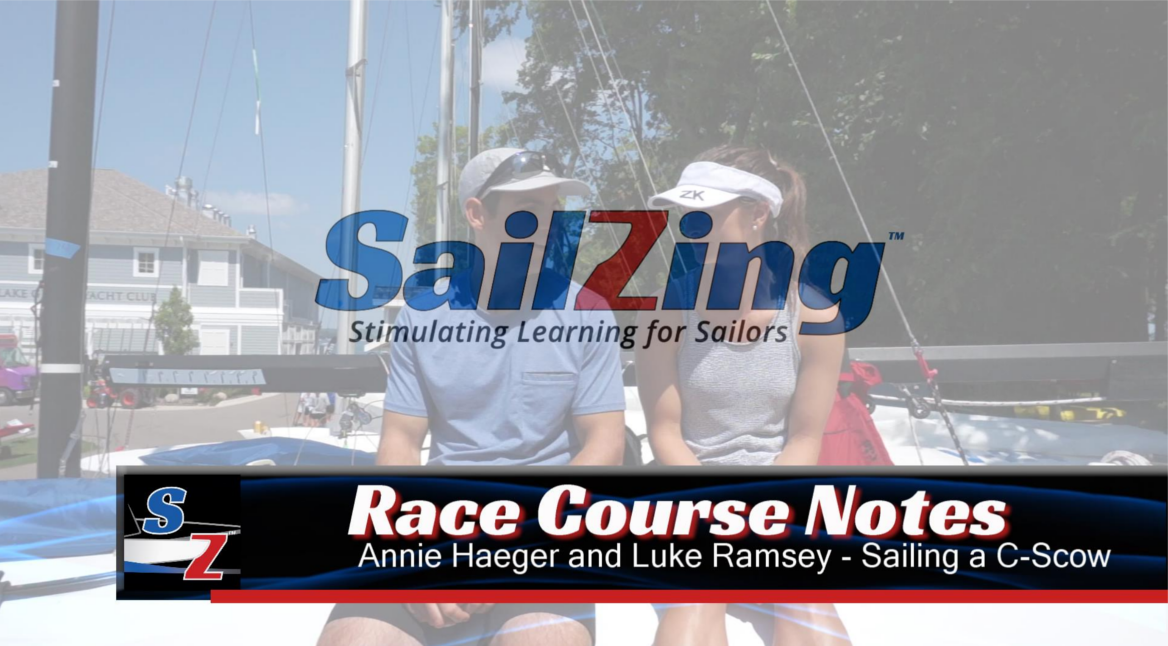“Get your head out of the boat” and “Sail by Feel” are both great pieces of advice for racing sailors, especially in small boats with limited (or zero) crew resources. This comes harder for sailors that didn’t grow up with a tiller in their hand. In this article, we’ll try to motivate you to work on this skill and suggest some practice techniques.
This post is updated from the original version, with additional tips and links..
Why Get Your Head Out of the Boat?
Winning sailors can sail at 95% or better speed with their head mostly out of the boat. After a race, any consistently successful sailor will be able to recall important strategic and tactical details about the race, including who was leading at various times, the major wind changes, the positions of the top contenders. That’s because they had their heads out of the boat, watching. Less skilled sailors have a harder time remembering details because they spent more of their time focused on sail trim, telltales, steering, compass, and other things in the boat.
What do successful sailors look for?
- Other boats – to determine position, spot changes in wind direction and velocity, adjust strategy, and anticipate tactical situations.
- Wind on the water – to anticipate puffs, lulls and shifts.
- Waves – to keep the boat moving.
- Course – to avoid mistakes such as overstanding and missing marks.
- Flags, trees, smoke, clouds – to further detect wind changes.
Sail by Feel to Get Your Head Out of the Boat
If you want to look around, you must learn to sail by feel, looking in the boat only when you’re uncertain about sail trim or steering. Like anything else, learning to sail by feel requires focused practice. We reviewed several sources and found the following practice techniques.
Verbalize Feel and Correct by Intuition
Sail alone upwind in moderately puffy, shifty conditions. Sail for several stretches of perhaps 5 minutes each. During each stretch, verbalize the feedback you are getting from the boat on one of the following. As you verbalize, use your intuition and feel to make adjustments without looking into the boat.
- Feel of the tiller. If you have excessive or too little helm, what’s the cause – angle of heel, over/under-powered, board angle, traveler position?
- Speed. Are you moving at top speed for the conditions?
- Sound of waves as hull moves through water.
- Feel of wind on face and neck. If fast, the apparent wind should be in your face.
- Are you accelerating or decelerating?
- Angle of heel. Get comfortable using the angle of the forestay to the horizon as a reference.
- In the groove. Are you in the groove – not pinching or sailing too low? Verbalize your guess, then check against your references (luff telltales).
- Mainsheet tension. The last 3-5″ of mainsheet tension are critical for speed. If you click the mainsheet in a touch, does it make the boat feel livelier? Same with easing? Is there a spot where the tension peaks? It helps to use a small diameter sheet, and sail without gloves if possible.
- Heeling force and hiking. Are you at maximum power for the conditions – hiking hard and holding the boat down? If not hiking, why?
- Wake and rudder. Lock the tiller on your lap and look aft. Is the rudder angle neutral? Is the wake symmetrical? What sound do you hear from the stern (bubbling or quiet)?
Develop the habit of testing
While sailing upwind in relatively steady breeze, or between puffs, practice making small changes in sail trim and steering and try to feel their effect. Several good sailors have said they do this constantly on the water so they can find the groove by feel, while still looking out.
Sail standing up
As a next step, try sailing upwind in a medium breeze while standing up and facing forward, either on the windward deck or in the cockpit. This may help you look at the water, as well as develop another way to feel the boat.
Sail blind
After you get more comfortable using your senses and testing, go out on a medium day with a crew or another boat and sail with your eyes closed. Use what you’ve learned to self-correct any sail trim or steering errors. Ask the observer to watch for other boats and give you feedback.
Sail a Different Boat
Increase your sense of feel by trying other boats in your class or in other classes. Trying to identify differences in feel will heighten your senses. Other boats in your class may have subtle differences. Boats in other classes will likely have larger differences.
Reduce Distractions and Noise
Limit on-board chatter to the important stuff and reduce any unnecessary distractions to let your sense of feel thrive.
Mark Control Settings
Going right to pre-determined settings (main sheet, vang, etc.) is another way to get your head out of the boat.
Related Content:
Manage Upwind Helm Balance for Speed and Feel
Mark Control Settings – Ger Fast, Quicker
Sailing senses: Tips from a blind winner – Yachts & Yachting
Fill Up Your Senses – Speed and Smarts Issue #92
Sailors Helping Sailors
Will you share your knowledge with your related Comments below?





